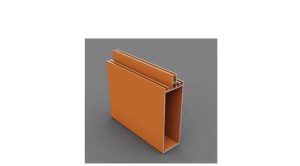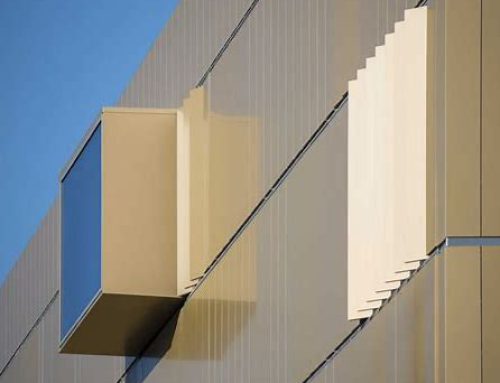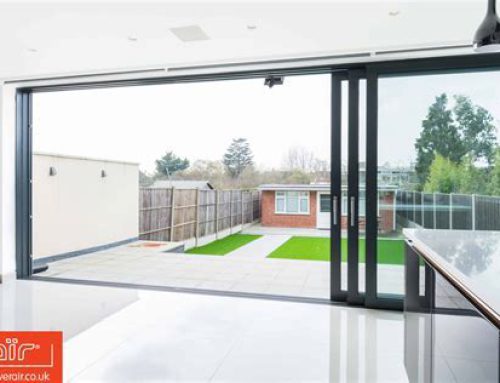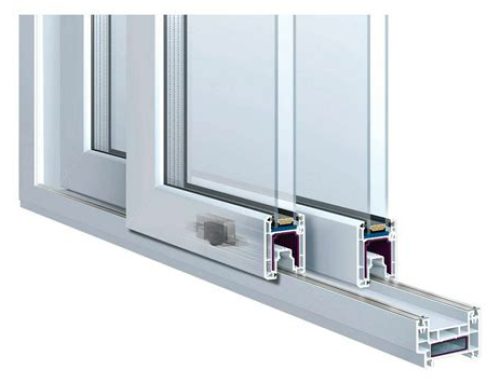U-Channel curtain wall systems

Introduction:
U-Channel curtain wall systems , In the realm of contemporary architecture, innovation and efficiency play pivotal roles in shaping the landscape of building design. One such technological advancement that has gained prominence in recent years is the U-Channel Curtain Wall System. This system, characterized by its sleek and versatile design, has become a popular choice among architects and builders for its aesthetic appeal and functional benefits.
Understanding U-Channel Curtain Wall System:
A U-Channel Curtain Wall System is a type of facade system commonly used in commercial and high-rise buildings. It is a non-structural cladding system that is designed to protect the building from the elements while providing an elegant and modern exterior. The term “U-Channel” refers to the aluminum extrusions used to hold the glass or other infill panels in place.
Advantages:
- Versatility in Design: One of the key advantages of U-Channel Curtain Wall System lies in their versatility. Architects can create a wide range of designs, from sleek and minimalistic to bold and intricate, using various combinations of glass, metal, and other materials. This adaptability allows for the creation of iconic and visually striking facades.
- Natural Light and Energy Efficiency: U-Channel Curtain Wall System are known for maximizing natural light within a building. The expansive glass panels allow sunlight to flood interior spaces, reducing the need for artificial lighting during daylight hours. This not only enhances the overall aesthetic but also contributes to energy efficiency by lowering electricity consumption.
- Thermal Performance: Advanced thermal break technology in U-Channel systems helps in improving the thermal performance of buildings. By minimizing heat transfer between the interior and exterior, these curtain walls contribute to better insulation and energy conservation. This aspect is crucial for meeting sustainability goals and optimizing a building’s energy efficiency.
- Weather Resistance: U-Channel Curtain Wall System are engineered to withstand various weather conditions, including wind, rain, and temperature fluctuations. The tight seals between the glass panels and the aluminum framework prevent water infiltration, ensuring the building remains dry and structurally sound. This durability makes U-Channel systems suitable for buildings in diverse climates.
- Cost-Effectiveness: While the initial cost of installing U-Channel Curtain Wall Systems may be higher than some traditional alternatives, the long-term benefits often outweigh the initial investment. The energy savings, reduced maintenance costs, and enhanced durability make U-Channel systems a cost-effective choice in the lifecycle of a building.
- Ease of Installation: U-Channel Curtain Wall Systems are designed for ease of installation. The modular nature of the system allows for efficient assembly on-site, reducing construction time and costs. This factor is particularly appealing for large-scale projects where timely completion is crucial.
Acoustic Performance:
Beyond the visual and thermal aspects, U-Channel Curtain Wall Systems also contribute to acoustic comfort within buildings. The use of laminated glass and specialized sealants helps minimize external noise, creating a more tranquil indoor environment. This feature is particularly crucial for buildings located in urban areas or near busy thoroughfares.
- Customization and Branding: U-Channel systems offer opportunities for branding and customization. The aluminum frames can be powder-coated in a variety of colors, allowing architects to incorporate a building’s branding or unique color scheme seamlessly into the facade. This level of customization enhances the building’s identity and contributes to its overall visual appeal.
- Maintenance and Durability: The durability of U-Channel Curtain Wall Systems is a key factor in their widespread adoption. The materials used, such as high-quality aluminum and tempered glass, are resistant to corrosion and degradation over time. Additionally, the low maintenance requirements make U-Channel systems an attractive option for building owners looking for long-lasting solutions with minimal upkeep.
- Green Building Certification: Sustainability is a driving force in modern construction, and U-Channel Curtain Wall Systems align with the goals of green building certification programs. These systems contribute to energy efficiency, daylighting strategies, and overall environmental performance, which are critical criteria for certifications like LEED (Leadership in Energy and Environmental Design) and BREEAM (Building Research Establishment Environmental Assessment Method).
- Integration with Smart Building Technologies: The adaptability of U-Channel systems extends to their compatibility with smart building technologies. Integrated sensors, automated shading systems, and other smart features can be seamlessly incorporated into the curtain wall design. This integration enhances occupant comfort, improves energy management, and contributes to the overall intelligence of the building.
- Resilience to Seismic Activity: In regions prone to seismic activity, the structural integrity of buildings is a top priority. U-Channel Curtain Wall Systems can be engineered to meet seismic design requirements, providing an additional layer of safety. The flexibility of the system allows it to absorb and dissipate seismic forces, contributing to the overall resilience of the building.
Challenges and Considerations:
Despite their numerous advantages, U-Channel Curtain Wall Systems are not without challenges. It’s essential for architects and builders to consider factors such as potential for thermal bridging, condensation risk, and the need for skilled installation to ensure optimal performance. Careful consideration of local climate conditions and building requirements is crucial to address these challenges effectively.
- Future Trends and Innovations: The evolution of U-Channel Curtain Wall Systems continues with ongoing research and development. Future innovations may focus on enhancing thermal performance further, integrating advanced materials, and incorporating even smarter technologies for improved building automation and energy efficiency. Keeping abreast of these developments will be essential for architects and industry professionals.
- Case Studies: Examining successful applications of U-Channel Curtain Wall Systems in real-world projects provides valuable insights. Case studies showcasing how these systems have been employed in various architectural contexts, from residential buildings to commercial skyscrapers, can serve as inspiration and inform best practices for future projects.
- Regulatory Compliance: As with any architectural element, compliance with local building codes and regulations is paramount. U-Channel Curtain Wall Systems must meet safety, structural, and energy performance standards. Architects and builders should stay informed about the latest regulatory requirements to ensure their designs align with legal and safety standards.
- Global Adoption and Cultural Influences: The adoption of U-Channel Curtain Wall Systems is not uniform across the globe. Cultural preferences, regional architectural styles, and climatic variations influence the choice of building materials and facade systems. Understanding these cultural nuances is essential for architects working on international projects to create designs that resonate with local aesthetics and preferences.
- Recommendations for Architects and Developers: For architects and developers considering the integration of U-Channel Curtain Wall Systems into their projects, several recommendations can enhance the success of implementation. Collaborating with experienced curtain wall specialists, conducting thorough site assessments, and considering the long-term maintenance requirements are essential steps. Moreover, engaging with manufacturers and suppliers who prioritize quality materials and offer customization options ensures that the chosen U-Channel system aligns with the specific needs and vision of the project.
- Education and Training: With the increasing prevalence of U-Channel Curtain Wall Systems, education and training become crucial aspects for professionals in the construction and architectural industries. Continuous learning about the latest advancements, installation techniques, and best practices associated with these systems will empower architects, engineers, and builders to make informed decisions and address challenges effectively.
Community Engagement:
Building projects using U-Channel Curtain Wall Systems often have a significant impact on the surrounding community. Engaging with local communities, obtaining feedback, and addressing concerns transparently contribute to successful project outcomes. Additionally, incorporating community-oriented design elements into the curtain wall system can create a positive relationship between the building and its surroundings.
- Sustainability and Circular Design: The pursuit of sustainability is a driving force in contemporary architecture. Architects and developers can further enhance the environmental credentials of U-Channel Curtain Wall Systems by considering recyclability, using eco-friendly materials, and incorporating circular design principles. This approach aligns with the broader industry shift towards creating buildings that have a minimal ecological footprint.
- Continuous Monitoring and Adaptation: The dynamic nature of the construction industry requires a commitment to continuous monitoring and adaptation. As buildings age and technologies evolve, regular assessments of U-Channel Curtain Wall Systems are necessary to ensure ongoing performance, address maintenance needs, and consider opportunities for upgrades or renovations that align with the latest advancements in the field.
- Looking Ahead: Evolution and Adaptation: The trajectory of U-Channel Curtain Wall Systems points toward a future characterized by continual evolution and adaptation. Architects and designers are likely to witness the integration of cutting-edge technologies, such as advanced glazing solutions, dynamic shading systems, and interactive components, further enhancing the functionality and aesthetic appeal of these systems. Keeping a keen eye on emerging trends will empower industry professionals to stay ahead of the curve and leverage the latest innovations in their designs.
- Global Collaboration and Knowledge Sharing: In an interconnected world, architects and developers are increasingly engaging in global collaborations. Knowledge sharing across borders and cultures fosters a rich exchange of ideas and best practices. The global community can collectively contribute to refining U-Channel Curtain Wall Systems, ensuring that they meet the diverse needs of different regions while adhering to high standards of quality and sustainability.
The Role of Artificial Intelligence and Computational Design:
The integration of artificial intelligence (AI) and computational design tools is poised to play a significant role in the optimization of U-Channel Curtain Wall Systems. These technologies can aid architects in generating designs that are not only visually stunning but also precisely engineered for maximum performance. AI-driven simulations can enhance the predictability of a system’s behavior under various conditions, leading to more robust and efficient designs.
- Resilience in the Face of Climate Change: As climate change continues to impact the built environment, the resilience of architectural elements becomes paramount. U-Channel Curtain Wall Systems, with their capacity for adaptation and durability, can contribute to the development of climate-resilient structures. Future designs may incorporate features that address extreme weather events, such as improved impact resistance and innovative materials capable of withstanding changing environmental conditions.
- Collaboration with Other Sustainable Practices: The future of U-Channel Curtain Wall Systems is intertwined with broader sustainable practices within the construction industry. Collaborations with renewable energy solutions, water conservation measures, and green infrastructure can create holistic, environmentally conscious buildings. Architects and developers may increasingly seek to integrate U-Channel systems into comprehensive sustainable designs that contribute positively to the well-being of both occupants and the planet.
- A Call to Sustainable Urban Development: Ultimately, the adoption and evolution of U-Channel Curtain Wall Systems align with a larger call for sustainable urban development. As populations grow and cities expand, the need for environmentally responsible architecture becomes increasingly urgent. U-Channel systems, with their aesthetic versatility and sustainable features, can be instrumental in shaping urban landscapes that prioritize energy efficiency, environmental stewardship, and the well-being of inhabitants.
Conclusion:
In conclusion, the journey of U-Channel Curtain Wall Systems is not just a narrative of architectural innovation but a testament to the industry’s commitment to sustainable, resilient, and visually captivating structures. As these systems continue to evolve, architects and developers must approach their integration with a forward-thinking mindset, considering not only the present needs but also the challenges and opportunities that the future holds. By embracing the ongoing advancements in technology, sustainable practices, and global collaboration, U-Channel Curtain Wall Systems can remain at the forefront of architectural excellence, contributing to the creation of spaces that inspire, endure, and harmonize with the world around them.





Leave A Comment